
Elementary Particles :
One of the primary goals in modern physics is to answer the question "What is the Universe made of?" Often that question reduces to "What is matter and what holds it together?" This continues the line of investigation started by Democritus, Dalton and Rutherford.
Modern physics speaks of fundamental building blocks of Nature, where fundamental takes on a reductionist meaning of simple and structureless. Many of the particles we have discussed so far appear simple in their properties. All electrons have the exact same characteristics (mass, charge, etc.), so we call an electron fundamental because they are all non-unique.
The search for the origin of matter means the understanding of elementary particles. And with the advent of holism, the understanding of elementary particles requires an understanding of not only their characteristics, but how they interact and relate to other particles and forces of Nature, the field of physics called particle physics.

Quarks and Leptons:
The two most fundamental types of particles are quarks and leptons. The quarks and leptons are divided into 6 flavors corresponding to three generations of matter. Quarks (and antiquarks) have electric charges in units of 1/3 or 2/3's. Leptons have charges in units of 1 or 0.
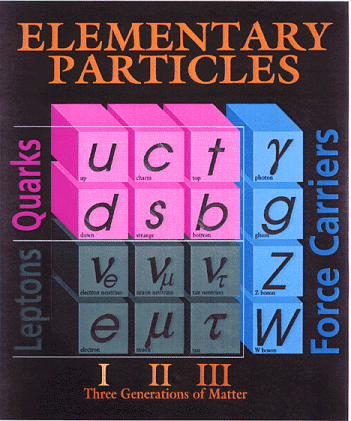
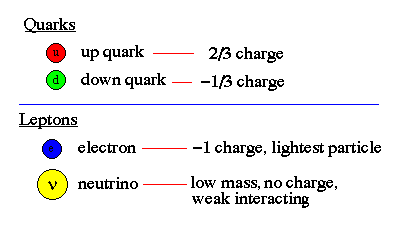
Fundamental Forces:
Matter is effected by forces or interactions (the terms are interchangeable). There are four fundamental forces in the Universe:
The first two you are familiar with, gravity is the attractive force between all matter, electromagnetic force describes the interaction of charged particles and magnetics. Light (photons) is explained by the interaction of electric and magnetic fields.
The strong force binds quarks into protons, neutrons and mesons, and holds the nucleus of the atom together despite the repulsive electromagnetic force between protons. The weak force controls the radioactive decay of atomic nuclei and the reactions between leptons (electrons and neutrinos).
Current physics (called quantum field theory) explains the exchange of energy in interactions by the use of force carriers, called bosons. The long range forces have zero mass force carriers, the graviton and the photon. These operate on scales larger than the solar system. Short range forces have very massive force carriers, the W+, W- and Z for the weak force, the gluon for the strong force. These operate on scales the size of atomic nuclei.
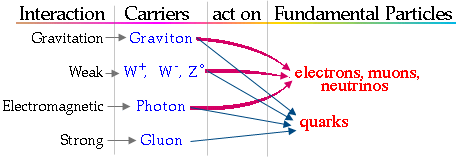
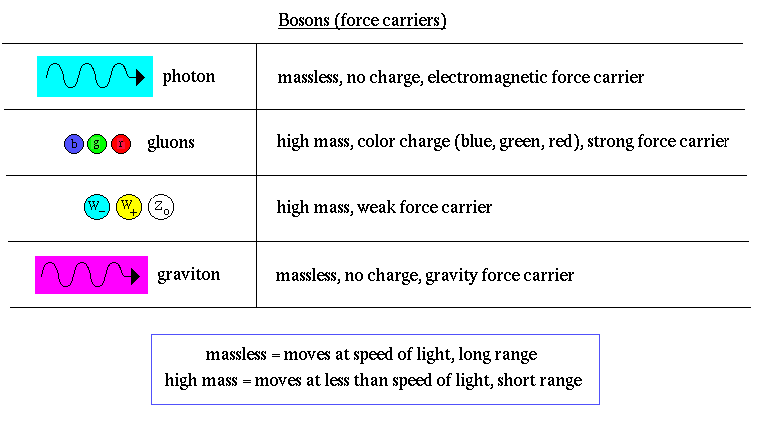
Baryons and Mesons:
Quarks combine to form the basic building blocks of matter, baryons and mesons. Baryons are made of three quarks to form the protons and neutrons of atomic nuclei (and also anti-protons and anti-neutrons). Mesons, made of quark pairs, are usually found in cosmic rays. Notice that the quarks all combine to make charges of -1, 0, or +1.
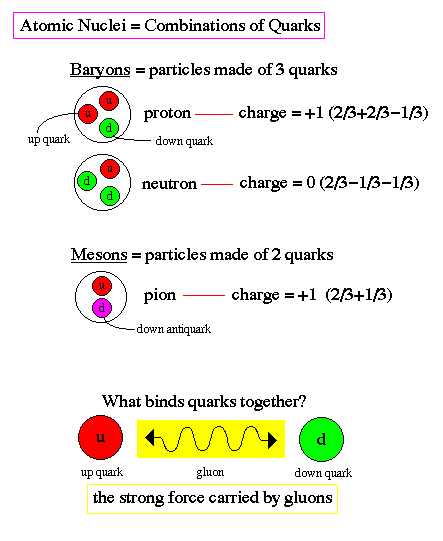

Color Charge:
Quarks in baryons and mesons are bound together by the strong force in the form of the exchange of gluons. Much like how the electromagnetic force strength is determined by the amount of electric charge, the strong force strength is determined by a new quantity called color charge.
Quarks come in three colors, red, blue and green (they are not actually colored, we just describe their color charge in these terms). So, unlike electromagnetic charges which come in two flavors (positive and negative or north and south poles), color charge in quarks comes in three types. And, just to be more confusing, color charge also has its anti-particle nature. So there is anti-red, anti-blue and anti-green.
Gluons serve the function of carrying color when they interact with quarks. Baryons and mesons must have a mix of colors such that the result is white. For example, red, blue and green make white. Also red and anti-red make white.
Quark Confinement:
There can exist no free quarks, i.e. quarks by themselves. All quarks must be bound to another quark or antiquark by the exchange of gluons. This is called quark confinement. The exchange of gluons produces a color force field, referring to the assignment of color charge to quarks, similar to electric charge.
The color force field is unusual in that separating the quarks makes the force field stronger (unlike electromagnetic or gravity forces which weaken with distance). Energy is needed to overcome the color force field. That energy increases until a new quark or antiquark is formed (energy equals mass, E=mc2).
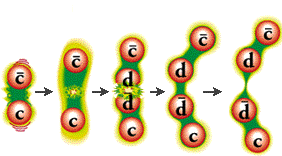
Quantum Electrodynamics :
The subfield of physics that explains the interaction of charged particles and light is called quantum electrodynamics. Quantum electrodynamics (QED) extends quantum theory to fields of force, starting with electromagnetic fields.
Under QED, charged particles interact by the exchange of virtual photons, photons that do not exist outside of the interaction and only serve as carriers of momentum/force.

Notice the elimination of action at a distance, the interaction is due to direct contact of the photons.
In the 1960's, a formulation of QED led to the unification of the theories of weak and electromagnetic interactions. This new force, called electroweak, occurs at extremely high temperatures such as those found in the early Universe and reproduced in particle accelerators. Unification means that the weak and electromagnetic forces become symmetric at this point, they behave as if they were one force.
Electroweak unification gave rise to the belief that the weak, electromagnetic and strong forces can be unified into what is called the Standard Model of matter.
Quantum Chromodynamics:
Quantum chromodynamics is the subfield of physics that describes the strong or ``color'' force that binds quarks together to form baryons and mesons, and results in the complicated the force that binds atomic nuclei together.

The strong force overcomes the electromagnetic or gravitational forces only on very short range. Outside the nucleus the effect of the strong force is non-existent.
Action at a Distance:
Newtonian physics assumes a direct connection between cause and effect. Electric and magnetic forces pose a dilemma for this interpretation since there is no direct contact between the two charges, rather there is an action at a distance.
To resolve this dilemma it was postulated that there is an exchange of force carriers between charged particles. These force carriers were later identified with particles of light (photons). These particles served to transfer momentum by contact between charged particles, much like colliding cars and trucks.

Theory of Everything:
Is that it? Are quarks and leptons the fundamental building blocks? Answer = maybe. We are still looking to fill some holes in what is know as the Standard Model.
The Standard Model is a way of making sense of the multiplicity of elementary particles and forces within a single scheme. The Standard Model is the combination of two schemes; the electroweak force (unification of electromagnetism and weak force) plus quantum chromodynamics. Although the Standard Model has brought a considerable amount of order to elementary particles and has led to important predictions, the model is not without some serious difficulties.
For example, the Standard Model contains a large number of arbitrary constants. Good choice of the constants leads to exact matches with experimental results. However, a good fundamental theory should be one where the constants are self-evident.
The Standard Model does not include the unification of all forces and, therefore, is incomplete. There is a strong expectation that there exists a Grand Unified Field Theory (GUTS) that will provide a deeper meaning to the Standard Model and explain the missing elements.
Supergravity:
Even a GUTS is incomplete because it would not include spacetime and therefore gravity. It is hypothesized that a ``Theory of Everything'' (TOE) will bring together all the fundamental forces, matter and curved spacetime under one unifying picture. For cosmology, this will be the single force that controlled the Universe at the time of formation. The current approach to the search for a TOE is to attempt to uncover some fundamental symmetry, perhaps a symmetry of symmetries. There should be predictions from a TOE, such as the existence of the Higgs particle, the origin of mass in the Universe.
One example of a attempt to formula a TOE is supergravity, a quantum theory that unities particle types through the use of ten dimensional spacetime (see diagram below). Spacetime (4D construct) was successful at explaining gravity. What if the subatomic world is also a geometric phenomenon.
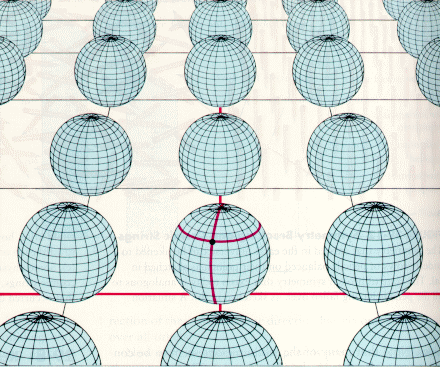
Many more dimensions of time and space could lie buried at the quantum level, outside our normal experience, only having an impact on the microscopic world of elementary particles.
It is entirely possible that beneath the quantum domain is a world of pure chaos, without any fixed laws or symmetries. One thing is obvious, that the more our efforts reach into the realm of fundamental laws, the more removed from experience are the results.
String Theory:
Another recent attempt to form a TOE is through M (for membrane) or string theory. String theory is actually a high order theory where other models, such as supergravity and quantum gravity, appear as approximations. The basic premise to string theory is that subatomic entities, such as quarks and forces, are actually tiny loops, strings and membranes that behave as particles at high energies.
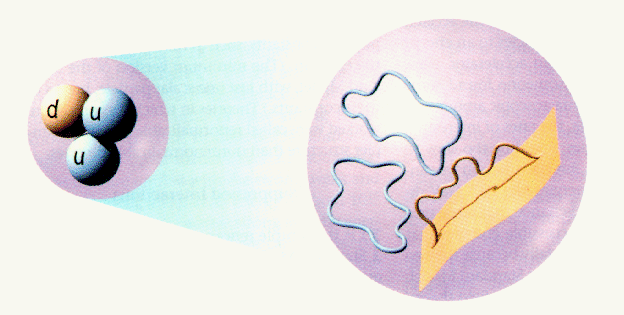
One of the problems in particle physics is the bewildering number of elementary particles (muons and pions and mesons etc). String theory answers this problem by proposing that small loops, about 100 billion billion times smaller than the proton, are vibrating below the subatomic level and each mode of vibration represents a distinct resonance which corresponds to a particular particle. Thus, if we could magnify a quantum particle we would see a tiny vibrating string or loop.
The fantastic aspect to string theory, that makes it such an attractive candidate for a TOE, is that it not only explains the nature of quantum particles but it also explains spacetime as well. Strings can break into smaller strings or combine to form larger strings. This complicated set of motions must obey self-consistent rules and the the constraint caused by these rules results in the same relations described by relativity theory.
Another aspect of string theory that differs from other TOE candidates is its high aesthetic beauty. For string theory is a geometric theory, one that, like general relativity, describes objects and interactions through the use of geometry and does not suffer from infinities or what is called normalization problems such as quantum mechanics. It may be impossible to test the predictions of string theory since it would require temperature and energies similar to those at the beginning of the Universe. Thus, we resort to judging the merit of this theory on its elegance and internal consistence rather than experiment data.

|
|

|